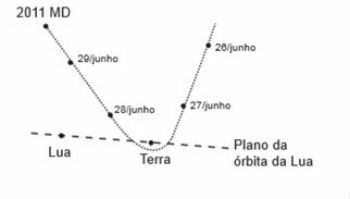Newton's First Law states that: "an object will remain at rest or in uniform motion in a straight line unless its state is altered by the action of an external force.."
Also called the Law of Inertia or the Principle of Inertia, it was conceived by Isaac Newton. He drew on Galileo's ideas about inertia to formulate the 1st Law.
The 1st Law, together with two other laws (2nd Law and Action and Reaction) form the foundations of Classical Mechanics.
Inertia
Inertia is the resistance offered by a body to changing its state of rest or movement. The greater the object's mass, the greater the inertia, that is, the greater the resistance that this body offers to changing its state.
Thus, the tendency of a body that is at rest is to remain at rest, unless some force comes to act on it.
Likewise, when the resultant of forces acting on a moving body is nil, it will continue to move.
In this case, the body will have a uniform rectilinear movement (M.R.U.), that is, its movement will be in a straight line and always with the same speed.

For there to be a change in the numerical value, in the direction or in the direction of velocity of a body, it is necessary to exert a force on this body.
Examples:
- When we are in a standing bus and it brakes abruptly, by inertia, we are thrown forward.
- When a car is going to make a turn, a force must act, otherwise the car will go in a straight line.
- By abruptly pulling the tablecloth covering a table, the objects that are on top, by inertia, stay in the same place.
- Seat belt use is based on the principle of inertia. The passengers of a vehicle, when colliding with another vehicle or when braking more abruptly, have the tendency to keep moving. In this way, without the belt, passengers can be thrown out of the vehicle or hit some of its parts.
Learn more at What is Inertia in Physics? and Galileo Galilei
Newton's Three Laws
the physicist and mathematician Isaac Newton (1643-1727) formulated the basic laws of mechanics, where he describes the movements and their causes. The three laws were published in 1687, in the work "Mathematical Principles of Natural Philosophy".
Newton's Second Law
THE Newton's 2nd Law establishes that the acceleration acquired by a body is directly proportional to the resultant of the forces acting on it.
It is expressed mathematically by:
Newton's Third Law
THE Newton's 3rd Law it is the Law of "Action and Reaction". This means that, for every action, there is a reaction of the same intensity, same direction and in the opposite direction. The principle of action and reaction analyzes the interactions that take place between two bodies.
When a body suffers the action of a force, another will receive its reaction. As the action-reaction pair occurs in different bodies, the forces do not balance.
To learn more, read also
- Newton's Laws
- Gravity
- Physics Formulas
Solved Exercises
1) Enem-2016
On June 27, 2011, the asteroid 2011 MD, about 10 m in diameter, passed within 12,000 kilometers of planet Earth, a distance less than the orbit of a satellite. The asteroid's trajectory is shown in the figure:

The physical explanation for the trajectory described is the fact that the asteroid
a) move to a place where air resistance is nil.
b) moving in an environment where there is no gravitational interaction.
c) undergo the action of a resultant force in the same direction as its velocity.
d) undergo the action of a gravitational force resulting in the opposite direction of its velocity.
e) be under the action of a resultant force whose direction is different from the direction of its velocity.
Alternative e: being under the action of a resultant force whose direction is different from the direction of its velocity.
2) PUC/MG-2004
Regarding the concept of inertia, it can be said that:
a) inertia is a force that keeps objects at rest or in motion at a constant speed.
b) inertia is a force that brings all objects to rest.
c) an object with a large mass has more inertia than one with a small mass.
d) objects that move quickly have more inertia than those that move slowly.
Alternative c: An object with a large mass has more inertia than a one with a small mass.
2) PUC/PR-2005
A body revolves around a fixed point held by an inextensible string and supported on a frictionless horizontal plane. At a given moment, the thread breaks

It is correct to say:
a) The body starts to describe a straight path in the direction of the wire and in the opposite direction to the center of the circumference.
b) The body starts to describe a straight path with a direction perpendicular to the wire.
c) The body continues in a circular motion.
d) The body stops.
e) The body starts to describe a straight trajectory towards the wire and towards the center of the circle.
Alternative b: The body starts to describe a straight path with a direction perpendicular to the wire.

